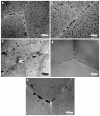A Review on Friction Stir Welding of High-Strength Al-Zn-Mg Alloy: Insights on Second-Phase Particles
- PMID: 39459812
- PMCID: PMC11509272
- DOI: 10.3390/ma17205107
A Review on Friction Stir Welding of High-Strength Al-Zn-Mg Alloy: Insights on Second-Phase Particles
Abstract
The friction stir welding (FSW) process is a unique combination of deformation and high temperature, which provides opportunities to modify microstructures through the adjustment of the processing parameters and is an ideal way to join non-weldable aluminum alloys by avoiding the formation of a molten pool. The 7xxx series heat-treatable aluminum alloys are widely used in the aerospace field as high-performance structural materials. The microstructure evolution and mechanical performance of these alloys are affected by the effects of thermomechanical processing, which provides opportunities to optimize the material properties by controlling microstructural features such as intermetallic constituent particles, dispersoids and nanoscale precipitates. This paper focuses on the basic principles of the thermal and mechanical effects generated during FSW on the evolution of second-phase particles in different zones of the weld.
Keywords: Al-Zn-Mg alloy; dispersoids; friction stir welding; intermetallic constituent particles; microstructure evolution; strengthening precipitates.
Conflict of interest statement
The authors declare no conflicts of interest.
Figures











Similar articles
-
Microstructure and Properties of Mg-Gd-Y-Zn-Mn High-Strength Alloy Welded by Friction Stir Welding.Materials (Basel). 2024 Aug 24;17(17):4190. doi: 10.3390/ma17174190. Materials (Basel). 2024. PMID: 39274580 Free PMC article.
-
Friction Stir Welding/Processing of Mg-Based Alloys: A Critical Review on Advancements and Challenges.Materials (Basel). 2021 Nov 8;14(21):6726. doi: 10.3390/ma14216726. Materials (Basel). 2021. PMID: 34772249 Free PMC article. Review.
-
Formation Mechanism of Thicker Intermetallic Compounds in Friction Stir Weld Joints of Dissimilar AA2024/AZ31B Alloys.Materials (Basel). 2022 Dec 21;16(1):51. doi: 10.3390/ma16010051. Materials (Basel). 2022. PMID: 36614388 Free PMC article.
-
Friction Stir Welding of Aluminum in the Aerospace Industry: The Current Progress and State-of-the-Art Review.Materials (Basel). 2023 Apr 8;16(8):2971. doi: 10.3390/ma16082971. Materials (Basel). 2023. PMID: 37109809 Free PMC article. Review.
-
Friction Stir Welding of Dissimilar Al 6061-T6 to AISI 316 Stainless Steel: Microstructure and Mechanical Properties.Materials (Basel). 2023 May 30;16(11):4085. doi: 10.3390/ma16114085. Materials (Basel). 2023. PMID: 37297219 Free PMC article.
Cited by
-
Influence of Zn Content on the Corrosion and Mechanical Properties of Cast and Friction Stir-Welded Al-Si-Mg-Fe-Zn Alloys.Materials (Basel). 2025 Jul 14;18(14):3306. doi: 10.3390/ma18143306. Materials (Basel). 2025. PMID: 40731518 Free PMC article.
References
-
- Safarbali B., Shamanian M., Eslami A. Effect of post-weld heat treatment on joint properties of dissimilar friction stir welded 2024-T4 and 7075-T6 aluminum alloys. Trans. Nonferrous Met. Soc. China. 2018;28:1287–1297. doi: 10.1016/S1003-6326(18)64766-1. - DOI
-
- Wahid M.A., Khan Z.A., Siddiquee A.N. Review on underwater friction stir welding: A variant of friction stir welding with great potential of improving joint properties. Trans. Nonferrous Met. Soc. China. 2018;28:193–219. doi: 10.1016/S1003-6326(18)64653-9. - DOI
-
- De Backer J., Bolmsjö G., Christiansson A.K. Temperature control of robotic friction stir welding using the thermoelectric effect. Int. J. Adv. Manuf. Technol. 2014;70:375–383. doi: 10.1007/s00170-013-5279-0. - DOI
-
- Liu G., Murr L.E., Niou C.S., McClure J.C., Vega F.R. Microstructural aspects of the friction—Stir welding of 6061-T6 aluminum. Scr. Mater. 1997;37:355–361. doi: 10.1016/S1359-6462(97)00093-6. - DOI
-
- Mishra R.S., Ma Z.Y. Friction stir welding and processing. Mater. Sci. Eng. R Rep. 2005;50:1–78. doi: 10.1016/j.mser.2005.07.001. - DOI
Publication types
LinkOut - more resources
Full Text Sources

